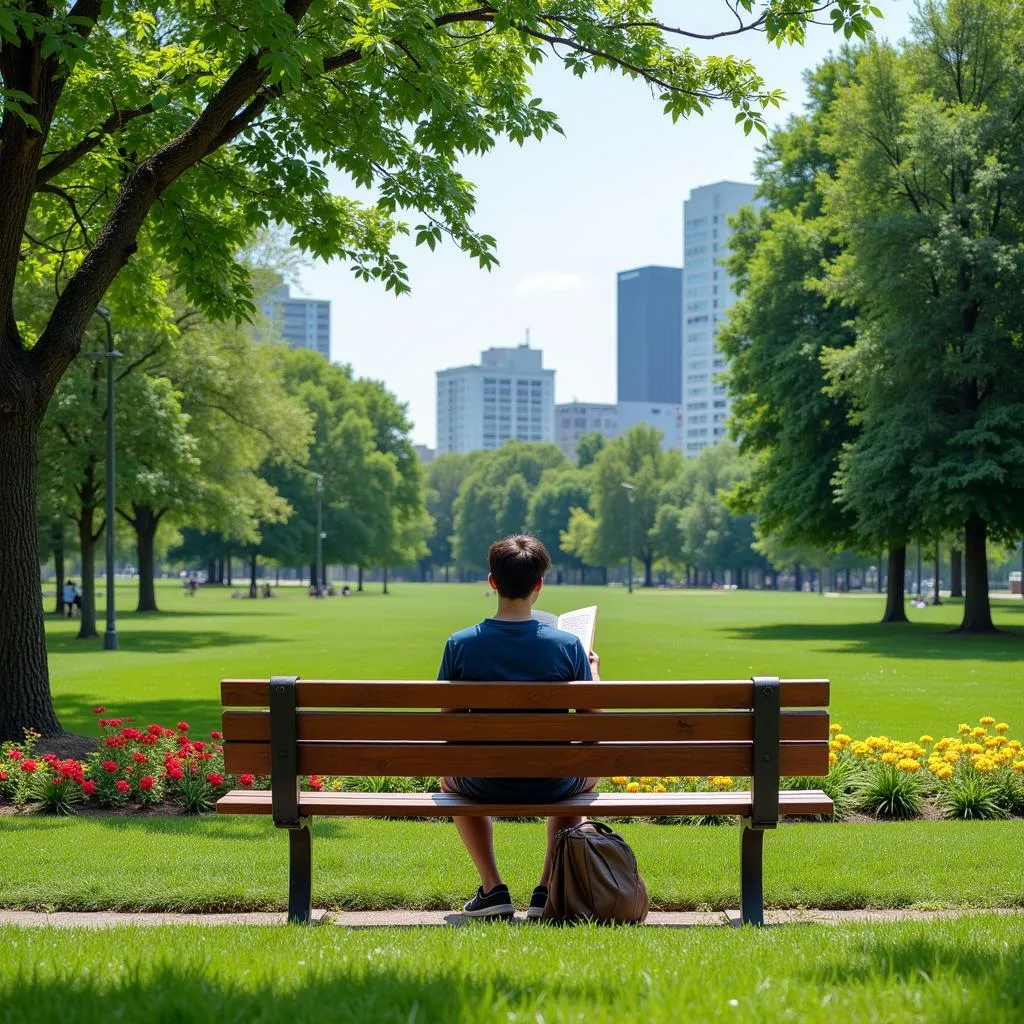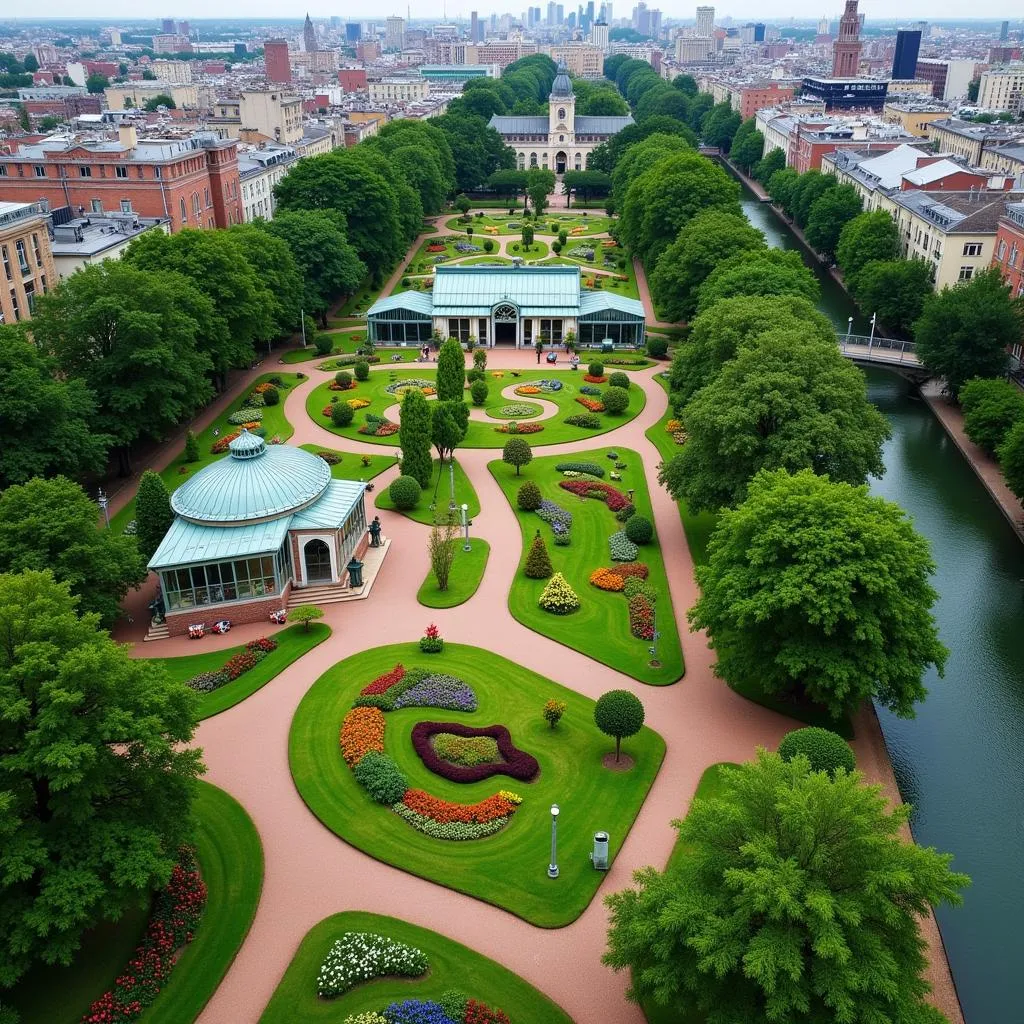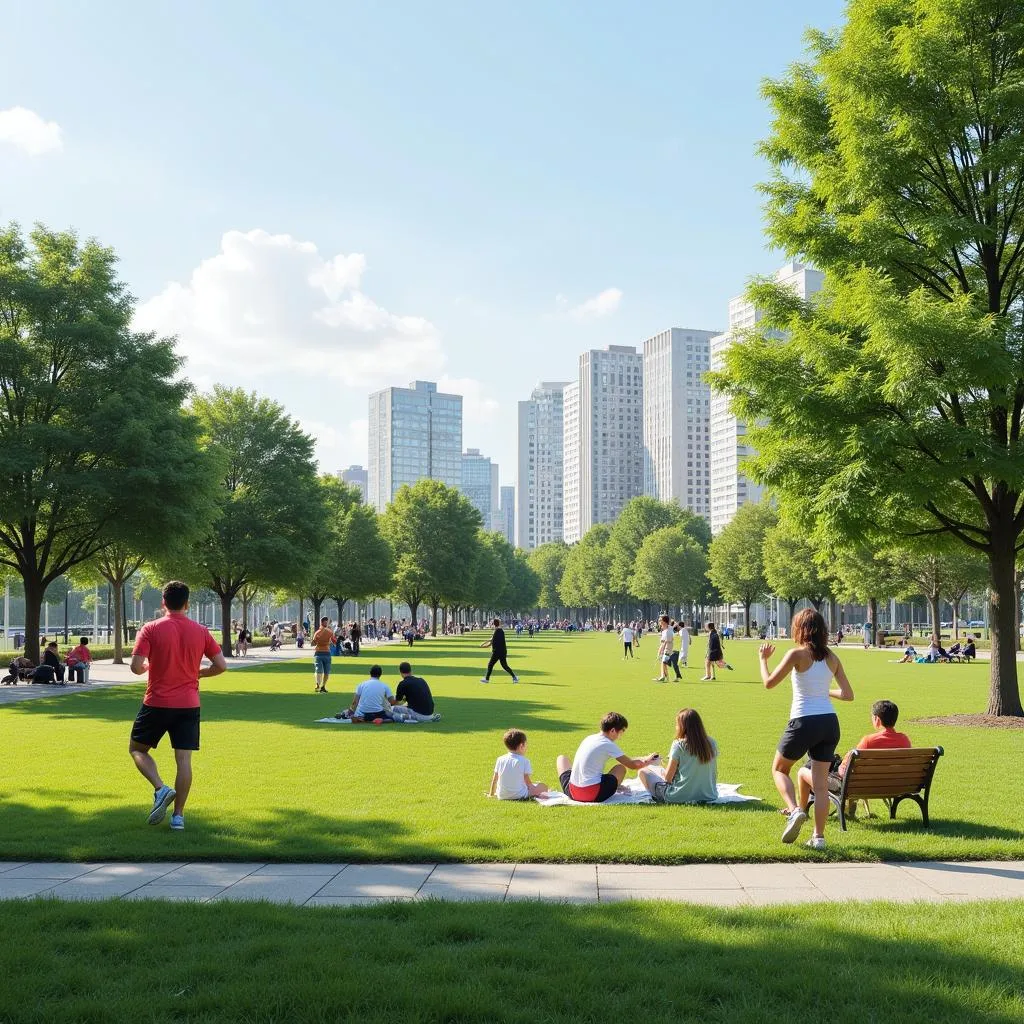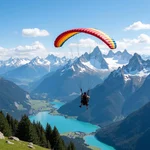The ability to describe a park or garden in your city is a valuable skill for the IELTS Speaking test. This topic frequently appears in various forms across all parts of the speaking exam, making it essential for test-takers to be well-prepared. Let’s explore how to effectively tackle this subject and achieve a high band score.
Part 1: Introduction and Interview
In this section, the examiner may ask general questions about parks and gardens. Here are some common questions you might encounter:
- Do you often visit parks or gardens in your city?
- What do you usually do when you go to a park?
- Are there any famous parks or gardens in your city?
- Do you think parks are important in urban areas?
Let’s look at a sample answer for the first question:
Examiner: Do you often visit parks or gardens in your city?
Band 6-7 Answer:
Yes, I do. I try to visit the local park near my house at least once a week. It’s a nice place to relax and get some fresh air after a busy day at work.
Band 8-9 Answer:
Absolutely! I make it a point to frequent the parks and gardens in my city quite regularly. In fact, I’d say I’m something of a park enthusiast. There’s a picturesque botanical garden just a stone’s throw from my apartment that I visit at least twice a week. It’s my go-to spot for unwinding and reconnecting with nature amidst the hustle and bustle of city life.
 Person relaxing on bench in urban park
Person relaxing on bench in urban park
Part 2: Long Turn
In this section, you’ll be given a cue card related to describing a park or garden. Here’s a sample cue card:
Describe a park or garden in your city that you like to visit.
You should say:
- Where it is located
- What it looks like
- What activities people do there
- And explain why you like visiting this place
Here are sample answers for different band scores:
Band 6-7 Answer:
I’d like to talk about Central Park in my city. It’s located in the heart of downtown, surrounded by tall buildings. The park is quite big and has many trees and flowers. There’s also a small lake in the middle.
People go there for various activities. Many like to jog or walk their dogs on the paths. Families often have picnics on the grass, and there’s a playground for children. Sometimes, there are concerts or events in the park during summer.
I enjoy visiting this park because it’s a peaceful place in the busy city. It’s nice to relax there and enjoy nature. The park is also well-maintained and clean, which makes it pleasant to spend time there.
Band 8-9 Answer:
I’d be delighted to describe one of my favorite urban retreats, Riverside Botanical Gardens, which is a verdant oasis nestled along the eastern bank of our city’s main river. This sprawling park spans nearly 50 acres and serves as a green lung for our bustling metropolis.
The gardens are a visual feast, boasting an eclectic mix of native and exotic flora. As you enter, you’re greeted by meticulously manicured lawns flanked by vibrant flowerbeds that change with the seasons. The centerpiece is undoubtedly the grand Victorian-style glasshouse, which houses a diverse collection of tropical plants. Winding paths lead visitors through various themed areas, including a serene Japanese garden, a fragrant herb garden, and a whimsical butterfly enclosure.
This multifaceted space caters to a wide array of activities. Fitness enthusiasts can be seen jogging along the river trail or participating in outdoor yoga classes. Art aficionados often gather for the regular plein air painting sessions, while horticulture hobbyists attend workshops on sustainable gardening practices. The park also hosts cultural events throughout the year, from open-air concerts to food festivals, making it a vibrant community hub.
What I find particularly enchanting about Riverside Botanical Gardens is its ability to transport visitors to a tranquil world, far removed from the urban cacophony. It’s not just a park; it’s a living, breathing ecosystem that offers a profound connection with nature. Whether I’m seeking inspiration for my writing, looking to decompress after a hectic week, or simply yearning for a peaceful sanctuary, this park never fails to rejuvenate my spirit and remind me of the intrinsic beauty of the natural world.
 Aerial view of Riverside Botanical Gardens
Aerial view of Riverside Botanical Gardens
Examiner’s follow-up questions:
- How do you think parks in cities might change in the future?
- What can local governments do to encourage more people to use public parks?
Sample answers:
Band 6-7 Answer (Question 1):
I think parks in cities might become more high-tech in the future. They might have better facilities like free Wi-Fi and charging stations for phones. Also, they might use more sustainable practices, like solar-powered lights and recycling systems.
Band 8-9 Answer (Question 1):
I envision future urban parks as multifunctional spaces that seamlessly blend nature with technology and sustainability. We might see the integration of smart technologies, such as interactive information kiosks and augmented reality experiences that educate visitors about local flora and fauna. Parks could also become hubs for renewable energy, with solar panels and wind turbines not only powering park facilities but also contributing to the city’s green energy grid. Moreover, I anticipate a greater emphasis on biodiversity and ecosystem services, with parks designed to support local wildlife, improve air quality, and mitigate urban heat island effects. These green spaces might also incorporate urban agriculture initiatives, allowing city dwellers to reconnect with food production and promoting community engagement.
Band 6-7 Answer (Question 2):
Local governments can organize more events in parks to attract people. They can also improve the facilities, like adding more benches and sports equipment. Making parks safer with better lighting and security could also encourage more visitors.
Band 8-9 Answer (Question 2):
Local governments can employ a multifaceted approach to boost park usage. Firstly, they could focus on enhancing accessibility by improving public transport links and creating safe cycling routes to parks. Diversifying park amenities to cater to various age groups and interests, such as installing outdoor fitness equipment, creating community gardens, or establishing areas for cultural performances, could attract a broader demographic. Implementing innovative programming, like guided nature walks, outdoor movie nights, or seasonal festivals, can transform parks into dynamic community spaces. Additionally, leveraging technology through park-specific mobile apps that provide information on events, flora and fauna, and allow users to contribute to citizen science projects could increase engagement. Finally, fostering community ownership through volunteer programs and participatory budgeting for park improvements can create a sense of stakeholdership, encouraging more frequent visits and active participation in park conservation efforts.
Part 3: Two-way Discussion
In this section, the examiner will ask more abstract questions related to parks and urban green spaces. Here are some potential questions and sample answers:
Examiner: What role do you think parks play in modern urban planning?
Band 6-7 Answer:
Parks are very important in modern cities. They provide green spaces for people to relax and exercise. Parks also help to reduce pollution and make cities look nicer. I think urban planners try to include parks to improve the quality of life for city residents.
Band 8-9 Answer:
Parks play a pivotal role in contemporary urban planning, serving as multifunctional spaces that address various urban challenges. Primarily, they act as green lungs for cities, helping to mitigate air pollution and reduce the urban heat island effect. Moreover, parks are crucial for promoting biodiversity within urban environments, providing habitats for local flora and fauna.
From a social perspective, parks serve as communal hubs, fostering social interaction and community cohesion. They offer equitable access to recreational spaces, which is particularly vital in densely populated areas where private outdoor spaces are limited. Parks also contribute significantly to public health initiatives by providing spaces for physical activity and mental relaxation, thus helping to alleviate the health issues associated with sedentary urban lifestyles.
In terms of urban aesthetics and economics, well-designed parks can enhance the visual appeal of cities and potentially increase property values in surrounding areas. They also play a role in sustainable urban development by helping with stormwater management and serving as carbon sinks.
Ultimately, I believe that urban planners increasingly view parks as essential infrastructure rather than mere amenities, recognizing their multifaceted benefits in creating livable, resilient, and sustainable cities.
 People interacting in urban park
People interacting in urban park
Examiner: Do you think there’s a conflict between preserving green spaces and the need for urban development?
Band 6-7 Answer:
Yes, I think there can be a conflict. Cities need to grow and build more houses and offices, but this often means using up green spaces. It’s a difficult balance because both development and green spaces are important for a city. Planners need to find ways to have both, maybe by creating more parks on top of buildings or including green areas in new developments.
Band 8-9 Answer:
The tension between preserving green spaces and urban development is indeed a complex and nuanced issue. While there’s often perceived to be an inherent conflict, I believe this dichotomy can be reconciled through innovative urban planning and a shift in our understanding of development.
Traditionally, urban development has been synonymous with expanding the built environment, often at the expense of green spaces. However, there’s a growing recognition that integrating natural elements into urban design is not just desirable but essential for sustainable urban growth. This paradigm shift is giving rise to concepts like “green urbanism” and “biophilic cities”, which seek to harmonize urban development with nature conservation.
That said, the pressure for development, particularly in rapidly growing cities, can still pose significant challenges to green space preservation. Land in urban areas is at a premium, and there’s often an economic incentive to develop rather than preserve. However, forward-thinking cities are finding creative solutions to this dilemma. These include mandating green space ratios in new developments, incentivizing green roofs and vertical gardens, and repurposing underutilized urban spaces into parks.
Moreover, there’s increasing evidence that well-planned green spaces can actually enhance urban development rather than hinder it. They can increase property values, attract businesses, improve public health outcomes, and make cities more resilient to climate change – all of which contribute to sustainable urban growth.
In conclusion, while the conflict between green space preservation and urban development is real, I believe it’s not insurmountable. By reframing our conception of urban development to inherently include green spaces, and by employing innovative design solutions, we can create cities that are both highly developed and richly endowed with natural elements.
Key Vocabulary and Phrases for High Scores
To elevate your speaking performance, incorporate these sophisticated words and phrases:
-
Verdant oasis /ˈvɜːrdənt ˈoʊeɪsɪs/ (noun phrase): A green, lush area in an otherwise dry or urban environment.
Example: The park serves as a verdant oasis in the heart of our concrete jungle. -
Multifaceted /ˌmʌltiˈfæsɪtɪd/ (adjective): Having many different aspects or features.
Example: The park’s multifaceted design caters to various interests and age groups. -
Rejuvenate /rɪˈdʒuːvəneɪt/ (verb): To give new energy or vigor to; revitalize.
Example: Spending time in the park helps rejuvenate my mind and body after a long week. -
Ecosystem services /ˈiːkəʊˌsɪstəm ˈsɜːrvɪsɪz/ (noun phrase): The benefits people obtain from ecosystems.
Example: Urban parks provide crucial ecosystem services, including air purification and temperature regulation. -
Biophilic design /ˌbaɪəʊˈfɪlɪk dɪˈzaɪn/ (noun phrase): An approach to architecture that seeks to connect building occupants more closely to nature.
Example: The new park incorporates elements of biophilic design, such as living walls and natural water features.
Examiner’s Advice
To achieve a high score in the IELTS Speaking test when describing parks or gardens:
-
Develop a rich vocabulary: Use a variety of descriptive words and phrases to paint a vivid picture of the park or garden.
-
Structure your answer: Organize your thoughts logically, covering all points in the cue card systematically.
-
Provide specific details: Instead of general statements, offer concrete examples and personal experiences.
-
Show critical thinking: In Part 3, demonstrate your ability to analyze complex issues related to urban green spaces.
-
Practice fluency: Aim for smooth delivery without long pauses or hesitations.
-
Use idiomatic expressions: Incorporate natural English phrases to enhance your language use.
-
Extend your answers: Especially in Parts 2 and 3, provide developed responses with explanations and examples.
Remember, consistent practice with a variety of topics will help you become more confident and proficient in your IELTS Speaking performance.
For more practice on describing places, you might want to check out how to describe a tourist attraction that is popular in your country or describe a nature spot where you often go to relax. These topics can help you expand your vocabulary and improve your descriptive skills, which are crucial for the IELTS Speaking test.


